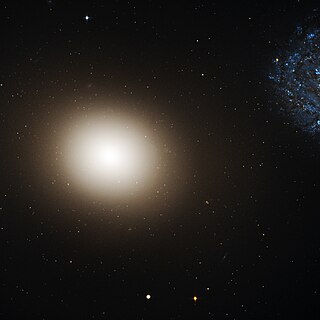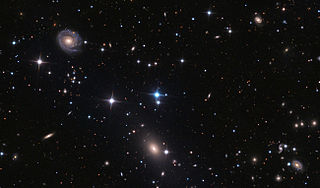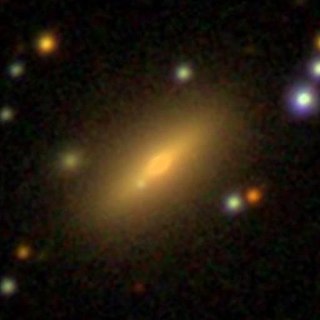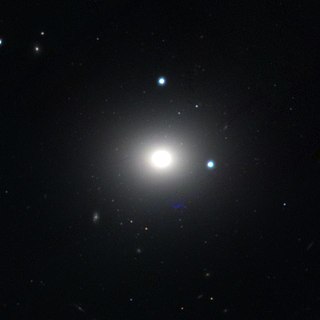
The Local Group is the galaxy group that includes the Milky Way, where Earth is located. It has a total diameter of roughly 3 megaparsecs (10 million light-years; 9×1019 kilometres), and a total mass of the order of 2×1012 solar masses (4×1042 kg). It consists of two collections of galaxies in a "dumbbell" shape; the Milky Way and its satellites form one lobe, and the Andromeda Galaxy and its satellites constitute the other. The two collections are separated by about 800 kiloparsecs (3×10^6 ly; 2×1019 km) and are moving toward one another with a velocity of 123 km/s. The group itself is a part of the larger Virgo Supercluster, which may be a part of the Laniakea Supercluster. The exact number of galaxies in the Local Group is unknown as some are occluded by the Milky Way; however, at least 80 members are known, most of which are dwarf galaxies.

Messier 59 or M59, also known as NGC 4621, is an elliptical galaxy in the equatorial constellation of Virgo. It is a member of the Virgo Cluster, with the nearest fellow member 8′ away and around 5 magnitudes fainter. The nearest cluster member of comparable brightness is the lenticular galaxy NGC 4638, which is around 17′ away. It and the angularly nearby elliptical galaxy Messier 60 were both discovered by Johann Gottfried Koehler in April 1779 when observing comet seeming close by. Charles Messier listed both in the Messier Catalogue about three days after Koehler's discovery.

Messier 60 or M60, also known as NGC 4649, is an elliptical galaxy approximately 57 million light-years away in the equatorial constellation of Virgo. Together with NGC 4647, it forms a pair known as Arp 116. Messier 60 and nearby elliptical galaxy Messier 59 were discovered by Johann Gottfried Koehler in April 1779, observing a comet in the same part of the sky. Charles Messier added both to his catalogue about three days after this.

A dwarf galaxy is a small galaxy composed of about 1000 up to several billion stars, as compared to the Milky Way's 200–400 billion stars. The Large Magellanic Cloud, which closely orbits the Milky Way and contains over 30 billion stars, is sometimes classified as a dwarf galaxy; others consider it a full-fledged galaxy. Dwarf galaxies' formation and activity are thought to be heavily influenced by interactions with larger galaxies. Astronomers identify numerous types of dwarf galaxies, based on their shape and composition.

NGC 4323 is a lenticular or dwarf elliptical galaxy located about 52.5 million light-years away in the constellation Coma Berenices. The galaxy was discovered in 1882 by astronomer Wilhelm Tempel and is a member of the Virgo Cluster.

NGC 1023, also known as the Perseus Lenticular Galaxy, is a barred lenticular galaxy, a member of the NGC 1023 group of galaxies in the Local Supercluster. Distance measurements vary from 9.3 to 19.7 million parsecs (30 to 64 million light-years). The supermassive black hole at the core has a mass of (4.4±0.5)×107 M☉. The black hole was discovered by analyzing the dynamics of the galaxy.

NGC 1277 is a lenticular galaxy in the constellation of Perseus. It is a member of the Perseus Cluster of galaxies and is located approximately 73 Mpc (megaparsecs) or 220 million light-years from the Milky Way. It has an apparent magnitude of about 14.7. It was discovered on December 4, 1875 by Lawrence Parsons, 4th Earl of Rosse.

NGC 6086 is an elliptical galaxy in the constellation of Corona Borealis. It has an apparent magnitude of 12.7. A Type-cD galaxy, it is the brightest cluster galaxy in the cluster Abell 2162. In 2010, a supermassive black hole was discovered in NGC 6086.

NGC 3862 is an elliptical galaxy located 300 million light-years away in the constellation Leo. Discovered by astronomer William Herschel on April 27, 1785, NGC 3862 is an outlying member of the Leo Cluster.

NGC 4494 is an elliptical galaxy located in the constellation Coma Berenices. It is located at a distance of circa 45 million light years from Earth, which, given its apparent dimensions, means that NGC 4494 is about 60,000 light years across. It was discovered by William Herschel in 1785.

NGC 1271 is a compact elliptical or lenticular galaxy located about 250 million light-years away in the constellation Perseus. The galaxy was discovered by astronomer Guillaume Bigourdan on November 14, 1884. NGC 1271 is a member of the Perseus Cluster and has a nuclear dust disk in its center. It also has an edge-on, intermediate-scale disk and has a central bulge. Like NGC 1277, NGC 1271 is a candidate "relic galaxy".

NGC 1281 is a compact elliptical galaxy located about 200 million light-years away in the constellation Perseus. NGC 1281 was discovered by astronomer John Dreyer on December 12, 1876. It is a member of the Perseus Cluster.

NGC 708 is an elliptical galaxy located 240 million light-years away in the constellation Andromeda and was discovered by astronomer William Herschel on September 21, 1786. It is classified as a cD galaxy and is the brightest member of Abell 262. NGC 708 is a weak FR I radio galaxy and is also classified as a type 2 Seyfert galaxy.

NGC 1395 is an elliptical galaxy located in the constellation Eridanus. It is located at a distance of circa 75 million light years from Earth, which, given its apparent dimensions, means that NGC 1395 is about 130,000 light years across. It was discovered by William Herschel on November 17, 1784. It is a member of the Eridanus Cluster.

NGC 3585 is an elliptical or a lenticular galaxy located in the constellation Hydra. It is located at a distance of circa 60 million light-years from Earth, which, given its apparent dimensions, means that NGC 3585 is about 80,000 light years across. It was discovered by William Herschel on December 9, 1784.

NGC 4636 is an elliptical galaxy located in the constellation Virgo. It is a member of the NGC 4753 Group of galaxies, which is a member of the Virgo II Groups, a series of galaxies and galaxy clusters strung out from the southern edge of the Virgo Supercluster. It is located at a distance of about 55 million light years from Earth, which, given its apparent dimensions, means that NGC 4636 is about 105,000 light years across.

NGC 759 is an elliptical galaxy located 230 million light-years away in the constellation Andromeda. NGC 759 was discovered by astronomer by Heinrich d'Arrest on September 17, 1865. It is a member of Abell 262.

NGC 4278 is an elliptical galaxy located in the constellation Coma Berenices. It is located at a distance of circa 55 million light years from Earth, which, given its apparent dimensions, means that NGC 4278 is about 65,000 light years across. It was discovered by William Herschel on March 13, 1785. NGC 4278 is part of the Herschel 400 Catalogue and can be found about one and 3/4 of a degree northwest of Gamma Comae Berenices even with a small telescope.

NGC 4318 is a small lenticular galaxy located about 72 million light-years away in the constellation Virgo. It was discovered by astronomer John Herschel on January 18, 1828. NGC 4318 is a member of the Virgo W′ group, a group of galaxies in the background of the Virgo Cluster that is centered on the giant elliptical galaxy NGC 4365.



















